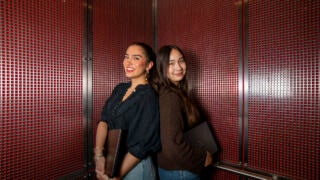Scientists search for source of creativity
It takes two to tango. Two hemispheres of your brain, that is.
USC researchers are working to pin down the exact source of creativity in the brain and have found that the left hemisphere of your brain, thought to be the logic and math portion, actually plays a critical role in creative thinking.
“We want to know how does creativity work in the brain?” said Lisa Aziz-Zadeh, assistant professor of neuroscience at the USC Dornsife College of Letters, Arts and Sciences.
If you paint or sculpt, you may think of yourself as right-brained. The right hemisphere of your brain often is thought to be the creative half, while the left is thought to be the rational, logical side.
But a new study from a team led by Aziz-Zadeh demonstrated that while the right half of your brain performs the bulk of the heavy lifting when you’re being creative, it does call for help from the left half of your noggin.
The study, which focuses on how the brain tackles visual creative tasks, supports previous findings about how the brain handles musical improvisation.
Co-authored by USC graduate student Sook-Lei Liew and USC undergraduate Francesco Dandekar, the study was posted online last month in Social Cognitive and Affective Neuroscience.
“We need both hemispheres for creative processing,” Aziz-Zadeh said.
The USC scholar and her team used functional magnetic resonance imaging to scan the brains of architecture students, who tend to be visually creative.
While being scanned, the subjects were shown three shapes: a circle, a C and an 8. They then were asked to visualize images that could be made by rearranging those shapes – for example, a face (with the 8 on its side to become the eyes, the C on its side to become the smiling mouth and the circle in the center as the nose).
The students also were asked to simply try to piece three geometric shapes together with their minds and see if they formed a square or a rectangle – a task that requires similar spatial processing but not necessarily creativity.
Even though it mainly was handled by the right hemisphere, the creative task actually lit up the left hemisphere more than the noncreative task. The results indicated that the left brain potentially is a crucial supporter of creativity in the brain.
Aziz-Zadeh said she plans to explore more of how different types of creativity (painting, acting, singing) are created by the brain, what they have in common and what makes them different.
Support for the research came from the Brain and Creativity Institute at the USC Dornsife College of Letters, Arts and Sciences, the USC Division of Occupational Science and Occupational Therapy, the National Science Foundation and the USC Provost’s Ph.D. Fellowship program.



